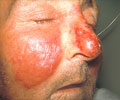Newborns with bloodstream infections can suffer serious complications with substantial morbidity and mortality.

The study, which included nearly 400,000 newborns, also found that infection rates in newborns increased with decreasing gestational age and birth weight. The overall rate of infection was 0.98 per 1,000 live births; 0.41 per 1,000 live births involving GBS and 0.28 per 1,000 live births involving E. coli.
The study appears online April 25 and in the May 2011 issue of Pediatrics.
GBS emerged as the leading cause of early-onset sepsis and meningitis in newborns in the 1970s. In 2002, the Centers for Disease Control and Prevention recommended universal screening of women at 35 to 37 weeks of pregnancy followed by chemoprophylaxis for women with GBS colonization.
Sepsis occurs when pathogenic bacteria enter the blood stream, causing systemic infection. In infants less than 72 hours old, sepsis is considered of early onset.
"Infections occur in almost one case per thousand live births," says Barbara Stoll, MD, lead investigator for the study. Stoll is the George W. Brumley, Jr., Professor and Chair, Department of Pediatrics in Emory University School of Medicine. "With approximately 4 million births a year in the United States, this equates to a substantial burden of disease. We estimate that approximately 3,000 infants a year develop early-onset sepsis. With current mortality rates, approximately 300 to 350 deaths per year are associated with neonatal sepsis. So, it's not inconsequential."
Advertisement
"Our findings suggest that accurate point-of-care diagnostic tests at the time a woman comes in for delivery would enhance our ability to identify at-risk women."
Advertisement
Source-Eurekalert











